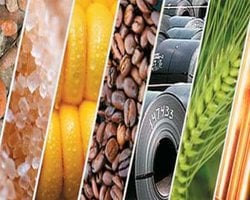October commodities were lower, mainly driven by agriculture and energy, due to expectations of increasing supply in certain commodities.
The global economy has recently started to improve, resulting in a return to pre-crisis macroeconomic uncertainty levels for the first time since the collapse of Lehman Brothers in 2008, says the University of Stanford’s daily US policy uncertainty index.
Nelson Louie, Global Head of Commodities in Credit Suisse’s Asset Management business, said:
“This may contribute to a further decrease in cross-asset class correlations, improving the diversification benefits of commodities. We continue to expect supply-side fundamentals to play an increasing role in individual commodity returns.”
Commodities down 1.48% in October
October saw a 1.48% fall in the Dow Jones-UBS Commodity Index Total Return. Thirteen out of 22 index constituents had negative returns
Below are some highlighted data on commodity movements in October 2013:
- Energy – 2.62% lower. Increases in inventories were greater than expected, which pulled down WTI Crude Oil. Mild weather forecasts brought Natural Gas down, as did expectations that production would continue to increase.

The end of this article has a clear explanation on what commodities are.
- Agriculture – 2.26% lower, driven primarily by Coffee and Cotton. Expectations of bumper US soybean and corn harvests had further affected the sector, as harvests were 59% and 77% complete (respectively) at the end of October. Expectations that the US will probably reduce its targets for renewable energy fuel usage had a negative effect on Corn prices.
- Precious metals – 0.01% lower. The Fed’s decision to continue pumping $85 billion each month into the economy helped prices, however, positive economic US data and a stronger dollar weighed down on the gains. Industrial metals rose by 0.42% (driven by Zinc and Nickel). Expected growing demand for Zinc pushed its price up. According to preliminary surveys, manufacturing in China has picked up in October. However, some indications, including export orders suggest the country’s economic recovery will be slow.
- Livestock – 1.45% higher, led by Lean Hogs. Live Cattle rose, but expectations of a fall in Cattle and Beef production may bring prices down in the fourth quarter.
Senior Portfolio Manager for the Credit Suisse Total Commodity Return Strategy, Christopher Burton, said:
“As anticipated, the October FOMC (Federal Open Market Committee) statement was very similar to that released after the FOMC’s previous meeting in September.
The future of fiscal policy will most likely hinge on if the federal government averts another shutdown in mid-January. A shutdown may also once again impact monetary policy, with the previous instance potentially forcing the Federal Reserve to delay tapering, after well-telegraphing it in the early summer.”
Burton added “The Fed has gone to great lengths to ensure the marketplace that they will err on the side of tightening too late rather than too early. While most are not currently concerned with inflation, it may materialize faster than expected should economic growth exceed expectations.”
China, the world’s largest buyer of commodities, is likely to have lower imports this month compared to record levels in October, according to Reuters. However, as the economic recovery accelerates, imports of iron ore, copper, and crude oil are expected to increase
The National reported that volumes on the DGCX (Dubai Gold and Commodities Exchange) have increased by 56% compared to one year ago “on the back of strong growth in precious metal contract trades.”
Gold at 3.5-week low
Spot Gold fell to $1,278.94 an ounce in early trade today, its lowest level in three-and-a-half weeks, after a greater-than-expected increase in US jobs growth fueled speculation that the Fed may start tapering its stimulus program.
Comex Gold futures for December fell to $1,281.80 an ounce, a decline of $2.80.
The Independent Online quoted VTB Capital analyst Andrey Kryuchenkov, who said “The dollar index is still holding fairly firm, and given the lack of physical interest or significant investor demand near new lows, there is very little upside for the market. Gold continues trading with macro headlines and against the greenback.”
What are commodities?
Commodities are things we get from the earth, such as gold, oil, cattle, wheat and coffee.
Humans need commodities to create a livable world. We use metals to make tools, devices, automobiles, weapons, etc., agricultural products to feed ourselves, and energy to keep warm/cool, for transportation, and to work our machines. Hence, there are three broad types of commodities:
- Energy
- Metals
- Agricultural products
People speculate when they buy and sell commodities. For example, if you think there is going to be a strike in South African gold mines, or a drought in Brazil, you will tell your commodity broker to buy as much coffee and gold as possible, because you think their prices will rise.
The purchase and sale of commodities is generally done through futures contracts on exchanges that have a standard measurement for the minimum quality and quantity of a traded commodity.
Commodities are bought and sold at Commodity Exchanges, examples include the Chicago Board of Trade, the New York Mercantile Exchange, the Tokyo Commodity Exchange, the Shanghai Futures Exchange, the London Commodity Exchange, the London Metal Exchange, and the European Energy Exchange.
The most commonly traded commodities globally are:
Crude Oil and derivatives, Coffee, Agriculture, Animals and Animal Products, Cocoa, Butter, Orange juice, Sugar, Metals, Precious Metals, Plastic, Natural Gas, and Bio-fuels.

